![[MetroActive Arts]](/arts/gifs/art468.gif)
[ Arts Index | Santa Cruz Week | MetroActive Central | Archives ]
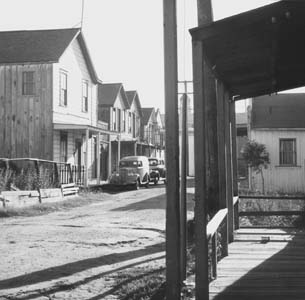 Bellevue Place, a.k.a. Santa Cruz Chinatown, 1940s: 'A ghost of a place,' writes Geogr Ow Jr., who grew up there. The Town Clock, then located on the Odd Fellows Building, can be seen in the background. Chinatown Dreams The life and photographs of George Lee By Geoffrey Dunn IN THE SPRING of 1941, burgeoning 19-year-old photographer George Lee was inspired to take a series of portraits of the aging men in the Santa Cruz Chinatown in which he himself had been raised. The men--named Chin Lai, Lee Lam Bok, Yee Hen Bok, Ah Fook and Moon Lai Bok--were the last of a generation who had come at the end of the nineteenth century to Gum Shan as they called it, the Land of Gold Mountain, working in the fields and laundries and gambling halls of the central California coast. They had came from China with dreams and aspirations for a better life but had found instead an institutionalized racism that marginalized them to the periphery of mainstream American society. This was particularly true in Santa Cruz, where their ramshackle Chinatown rested precariously on stilts in the flood plain of the San Lorenzo River and the ghosts of vigilantes from a vicious anti-Chinese movement a half-century earlier rustled in the willows surrounding their clapboard homes. Lee, then a student at Salinas Junior College (today Hartnell), had been an avid photographer in his youth, taking photos for the Santa Cruz High student newspaper and yearbook, and had recently saved up enough money to purchase a high-grade, German-made Rolleicord camera. Lee knew and loved the men he photographed. Indeed, they were a part of the very fabric of his life. Many years later, Lee, a lifelong friend of mine, told me that he viewed the aging men as "natural subject matter" for his growing interest in photography. "They probably wouldn't let anybody else take pictures of them." A remarkable collection of Lee's photographs--spanning six decades of his life in Santa Cruz and his varied journeys around the world--is now on display at the Museum of Art and History through Jan. 21 of next year. The exhibit, curated by recent Peabody Award winner Nikki Silva and beautifully designed by her husband Charles Prentiss, with the assistance of Jo Aribas, presents an impressive body of Lee's work, along with some delightful memorabilia from Lee's life as a photographer. Giving voice to the exhibit are the poignant reminiscences of Lee's nephew, George Ow Jr., who was born and raised in the Santa Cruz Chinatown. His late mother, Emily Lee Ow, was George Lee's sister. One of my favorite photos in the Lee collection is the intergenerational image--used on the MAH exhibit's poster--of Ah Fook and the 7-year-old Ow holding a can of sweetened, condensed milk. Ah Fook was a widely respected fisherman on the Santa Cruz waterfront and a lifelong bachelor, and if you look closely at the photo, the elderly man's gnarled fingers are gripping the young boy by the arm, as if laying a claim to a personal legacy in the youth's future. "I knew them at the end," Ow has written, "their youth and vigor used up by more than a half-century of labor building America, living with other lonely bachelors as they watched their peers die off until only a few survived. "But a new day was coming. They saw the strength of Uncle George and Uncle Hong and my dad. With World War II, they saw that even Chinese could get good jobs at the shipyards and serve in the armed services. But now they were too old. Chin Lai told my father, then strong and twenty-something, 'You are lucky. You came at the right time. ...' It was too late for them."
IT WOULD NOT BE too late for George Lee. His lifelong accumulation of photos constitutes one of the most important collections of photographic images in the California archive. Lee's artistically rendered portraits and landscapes document a significant era and experience in California history, one that went largely undocumented by mainstream photographers. As the son of immigrants, Lee constructed an inside--and profoundly intimate--view of a California Chinese-American community, one that would ultimately span five generations by the time of his untimely death in the summer of 1998. Lee lived and breathed photography. He was a consummate professional and a highly trained artist. He began his formal training in photography as a teenager, and he would continue to earn a living in his beloved trade for the rest of his life. He identified so closely with the profession that in literally hundreds of self-portraits and casual family snapshots, he is holding some form of photographic equipment, most often a camera. In addition to being a highly celebrated, award-winning documentary photographer, Lee was additionally a photo news journalist for local newspapers and the Associated Press, and a commercial photographer for several other regional publications. He also won numerous awards for photographic equipment displays and taught photography at the collegiate level to several generations of students on the central California coast. His brother-in-law George Ow Sr., who arrived in Santa Cruz from China as a teenager in the 1930s and who was immediately befriended by Lee, says of his late brother-in-law "that he must have been born with a camera in his hand. That's just who he was." Two years after his death, it is all but impossible to think of him as separate from his craft.
GEORGE LEE was born in San Francisco, Calif., Dec. 19, 1922. As a young boy, he also was known by the Chinese nickname of "Go," Cantonese for "the tall one." His father, Lee Sung Si, a native of Canton, China, had come to America some time around the turn of the century as a "paper merchant," which allowed him entry into California during a period of profoundly limited Chinese immigration. His mother, Lee Gue She, who was born in a southern Chinese village near Macao in 1900, had arrived in San Francisco in the immediate aftermath of World War I. She was nearly two decades younger than her husband. When Lee was 3 years old, the family relocated briefly to Tracy, in the sweltering San Joaquin Valley, then to Santa Cruz, where his father took a job as a cook on the Wilder Dairy Ranch. He worked six days a week on the ranch, then returned by train to the family home for Sunday dinners. The family eventually grew to seven children--George, followed by Emily, Rose, Wee, Young, Luella and Jun. The family lived in what was the fourth of Santa Cruz's Chinatown communities, commonly referred to as Birkenseer's Chinatown, on Bellevue Place (where the Galleria Building and Riverfront Theaters are located today). Nestled between the San Lorenzo River and Pacific Avenue, it was also bordered on the north by the landmark Garibaldi Hotel, a colorful rooming house, saloon and restaurant frequented by working-class Italian immigrants of the region. Later in his life Lee observed that "most of my childhood friends were Italians." Indeed, it was one such childhood friend, Frank Del Bianco, who introduced him to photography as a young teenager. "He was the smart one," Lee would later quip. "He went into banking." Lee was educated in local schools--Laurel Elementary (now the Louden Nelson Community Center) and Mission Hill Junior High--before entering Santa Cruz High School in the fall of 1936. He had already developed a reputation as a solid photographer by then, working after school and during the summer for the Camera Shop, an early photography business on Walnut Avenue. After graduating from high school in January of 1941, Lee continued his studies--including photography--at the nearby junior college in Salinas.
AMERICAN PHOTOGRAPHY had experienced a major renaissance during the 1930s with the formation of the Federal Photography Division of the Resettlement Administration, later to become the Farm Security Administration (FSA), under the direction of Roy Emerson Stryker. Photographers such as Walker Evans, Dorothea Lange, Arthur Rothstein and John Vachon were all hired by Stryker during the height of the Depression, and their photographs came to dominate the visual landscape of the nation for the better part of a decade.
The teenaged Lee was clearly influenced by these photographers. In an interview I conducted with him in the 1980s, Lee noted that the images of the FSA photographers, along with those of Edward Steichen, Ansel Adams and Unlike the FSA photographers, however, who traveled around the country in search of poverty or what anthropologists call "the other," Lee photographed his own community in Santa Cruz's Chinatown. In certain respects Lee's now-famous portraits of the men who were "longtime Californ'," echo those of the FSA photographers. The lines on these aged men's faces flow into the weathered wood grains of the weathered redwood buildings of Chinatown. There is an artistry to them strikingly reminiscent of Evans' facial portraits of the Burroughs, Fields and Tengle families in Hale County, Ala., that appeared with James Agee's prose in the legendary Let Us Now Praise Famous Men. The defining difference, of course, is the absence of distance between Lee and his subjects. The elderly men in Lee's portraits are neither portrayed as "the other" nor as exotic. Nor are they victimized as poster children for poverty, as were the subjects of many FSA photographs, most notably those of Evans and Lange. They are humanized--rendered as equals between the photographer, subject and audience. We are not asked to take pity on them; we are asked to encounter them as individual human beings. This was no accident. Like Toyo Miyatake, a Japanese American photographer who is best known for having smuggled a lens and film into the Manzanar concentration camp during World War II, Lee was chronicling a community of which he was a part. He was an insider looking in. While Lee's images lack some of the dramatic elements and artistic framing of Lange's and Evans' more celebrated photographs, in a very real sense they are more immediate and more accurate as documentary images. There is a complexity to Lee's documentary construction of human life shamefully lacking in many of the FSA photos.
AT THE AGE of 20, Lee enlisted in the U.S. Navy, where he served as a military photographer throughout World War II (and later in the Korean War). He undertook aerial-photography training in Pensacola, Florida, and was then sent to combat zones throughout the Pacific theater. Like many men of his generation, World War II and his service provided a defining moment in Lee's life. Lee's documentary photos from this era--Tonkinese women selling grass skirts, fishermen and their canoes in the New Hebrides, American sailors celebrating VJ Day--are taken from the perspective of an enlisted man. There is an ease and egalitarian quality to his images noticeably lacking in both the formal government photographs, as well as journalistic images, of the times. Following the war, Lee returned home to Santa Cruz and immediately went to work in the business of photography. His wartime buddy Eddy Webber started a camera business on Pacific Avenue, and Lee became a fixture there for the next 40 years. George Ow Jr. points out that his uncle was "one of the first Chinese-Americans in Santa Cruz to be hired to work 'up front' in a retail store not owned by a Chinese." In June of 1949, Lee married his longtime sweetheart, Priscilla Wong, who had immigrated to the U.S. from Canton in 1940. The Lee family and Priscilla's father had been friends in the Santa Cruz Chinatown during the Depression, and George and Priscilla's courtship became formal once George returned to Santa Cruz from the war. Lee's photographs began appearing regularly in the Santa Cruz Sentinel upon his return to Santa Cruz, and some, like a Chinese New Year photo of his daughter Patti, were picked up by the Associated Press. Lee also became a beloved teacher of photography throughout the region. He taught literally hundreds of local students at Cabrillo College, Harbor High and Santa Cruz Adult School, and was instrumental in bringing dark rooms to Harbor High and Mission Hill Junior High. He took courses and kept up with innovations in the profession until he died.
WHILE HIS LIFE and artistic vision sprang from a California Chinatown, it should be duly noted that Lee's artistry transcended the Chinatown of his youth and early adulthood. The more than 100 photographs collected for the MAH exhibit--and a forthcoming book--reflect just a small sampling of his photographic oeuvre. Lee took landscape photographs of the Sierra Nevada during the winter, for instance, that are reminiscent of Adams and Weston. He took travel photos on his journeys around the world that were suitable for publication in National Geographic. He documented the Miss California Pageant in Santa Cruz for decades and recorded floods and earthquakes and building demolitions. He also composed beautiful photographic landscapes, in particular the San Lorenzo River, on which he spent so much time in his youth. And finally, he took thousands of "snapshots" of his family that would fit comfortably into family scrapbooks across America. Indeed, if there was one thing that rivaled photography with George Lee, it was his family, so much so that the two are inexorably linked in his photographs. One wall of the MAH exhibit is devoted to photographs of his beloved wife, Priscilla, in the early years of their marriage. Several others chronicle the childhood of his daughter Patti. While serving as fascinating social documents, they are also intimate, infused with the love of a husband and father. During the 1980s, with the publication of Sandy Lydon's seminal work, Chinese Gold: The Chinese of the Monterey Bay Region, Lee was inspired to pull out his old prints and negatives for inclusion in Lydon's book, a subsequent museum exhibit and a documentary film. It was at that time that his work first became part of the region's public record and that his artistic talents were duly recognized. "George's photographs snapped my perspective around 180 degrees," Lydon noted. "Not only were they taken from inside the community, but they captured the textures of everyday life. His photographs were not about the Lunar New Year, or dragon parades, but of dirt streets, wooden porches, a kid's bicycle, and the furrowed faces of old men marooned in a country that never understood them." Three years ago, Lee agreed to an exhibit and book project that focused solely on his work. He was reluctant at first, but the idea gradually grew on him and he was well into the process of making the final selection for the book and the exhibit, when he was suddenly stricken with a series of powerful strokes. He died, with three generations of his family surrounding him, in the summer of 1998. His spirit and photographic vision, however, live on. The powerful photographs collected at the MAH provide a fascinating chronicle of our community in the 20th century--and a marvelous posthumous gift for those of us who have survived into the 21st. "I knew back then that my photos would be of historical value," he told me shortly before he died. "I knew they were worth saving. I just didn't know it would all fly by so quickly."
Geoffrey Dunn is the editor of Chinatown Dreams: The Photographs of George Lee, to be published next year by the Capitola Book Company. Chinatown Dreams shows through Jan. 21 at the Museum of Art and History, 705 Front St., Santa Cruz. (429.1964) [ Santa Cruz Week | MetroActive Central | Archives ]
|
From the October 18-25, 2000 issue of Metro Santa Cruz.
Copyright © Metro Publishing Inc. Maintained by Boulevards New Media.
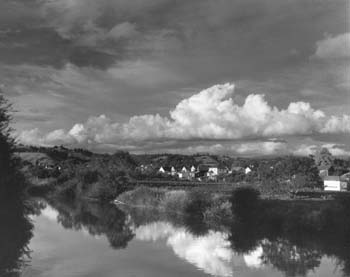
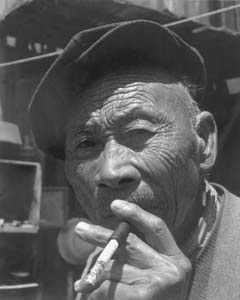 Yee Hen Bok (right) smoking self-rolled Bull Durham cigarette, Santa Cruz Chinatown, 1941.
Yee Hen Bok (right) smoking self-rolled Bull Durham cigarette, Santa Cruz Chinatown, 1941.
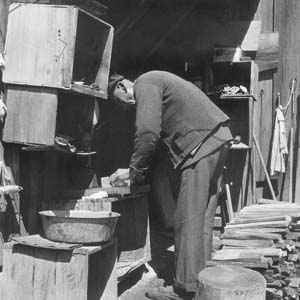
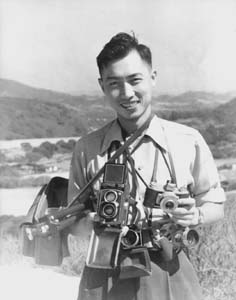 Gold Mountain Dreamers: George Lee (top), self-portrait with cameras, late 1940s.
Gold Mountain Dreamers: George Lee (top), self-portrait with cameras, late 1940s.
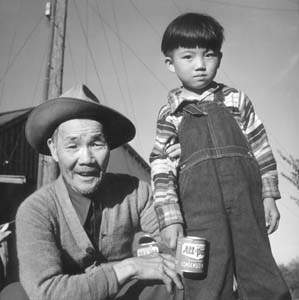 Ah Fook and George Ow Jr. (holding can of condensed milk), Santa Cruz Chinatown, 1948.
Ah Fook and George Ow Jr. (holding can of condensed milk), Santa Cruz Chinatown, 1948.